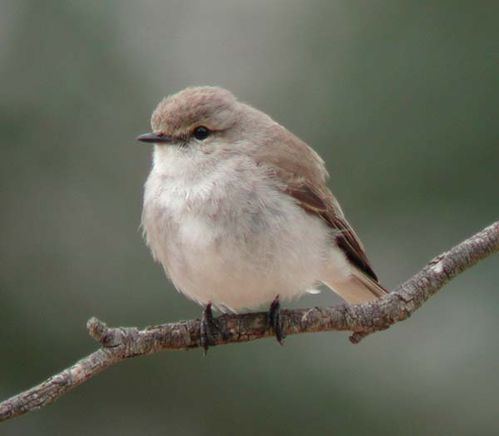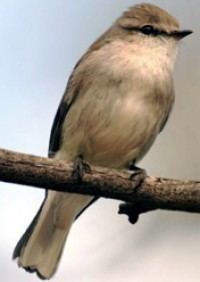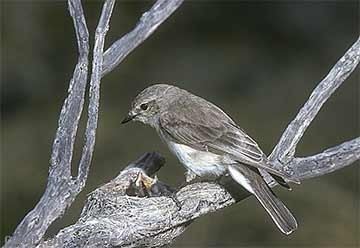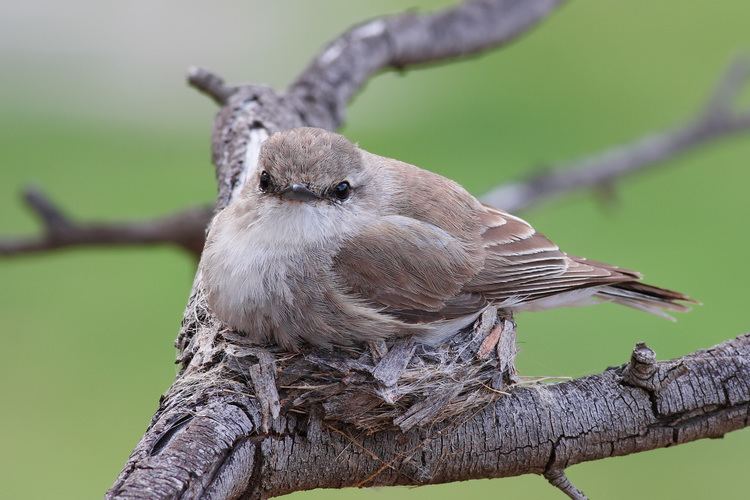Phylum Chordata Rank Species | Family Petroicidae Scientific name Microeca fascinans Higher classification Microeca Order Passerine | |
 | ||
Similar Bird, Microeca, Hooded robin, Restless flycatcher, Dusky woodswallow | ||
Jacky winter bird watching in australia with ej birdwatching
The jacky winter (Microeca fascinans) is a small grey-brown robin found commonly throughout Australia and also in Papua New Guinea. The jacky winter acquired its name due to rapid and strong vocalisations which sound like jacky-jacky winter-winter. Their call is also often referred to as sounding like peter-peter-peter. Its habitats include open woodlands and farmlands.
Contents
- Jacky winter bird watching in australia with ej birdwatching
- Jacky winter microeca fascinans
- Taxonomy and distribution
- Description
- Behaviour
- Diet
- Reproduction
- Status
- Threats
- References
Jacky winter microeca fascinans
Taxonomy and distribution

The jacky winter belongs to the family of Australasian robins and flycatchers; Petroicidae. This genus includes around 45 species in around 13 genera that are all endemic to Australasia. The family Petroicidae evolved in a similar way to the Australo-Papuan warblers (Acanthizidae). This family evolved in isolation, away from similar families (Parulidae and Sylviidae), to fill an ecological niche which was already being used in other continents such as Central America/South America and Asia respectively. Petroicidae evolved to fill an ecological niche in the Australo-Papuan area which was already being used by New World flycatchers (Tyrannidae) in North America and South America and Old World flycatchers (Muscicapidae) in Europe, Africa and Asia. This type of evolution is an example of convergent evolution.

There are three races of jacky winter found in Australia; Microeca fascinans fasinans (leucophaea) is the most familiar race and found in parts of Queensland, New South Wales, Victoria and South Australia. There is also Microeca fascinans assimilis which is found in South Australia and Western Australia and Mircoeca fascinans pallida which is found in Western and North Queensland, Northern Territory and North Western Australia.The Microeca fascinans zimmeri is a sub species of jacky winter found in Papua New Guinea
Description

The jacky winter is around 12 – 14 cm in length (including the tail) and its weight varies from 14 – 18 g. The plumage of M. f. fascinans includes a greyish breast with white on the bottom half, its head and back is greyish-brown, while its wings are a darker brown with white edges. The bill is black, it has a narrow eye-line and a buff alula stripe. The tail of M. f. fascinans is blackish brown with white outer feathers. Its legs are black. Subspecies M. f. assimilis is very similar to M. f. fascinans, however it is darker, with more grey over the breast and flanks, covering up the white which is seen on M. f. fascinans. M. f. pallida is smaller than the other two subspecies being only around 13 cm. M. f. pallida is much more pallid than the other subspecies and are usually a sandy brown colour.
Behaviour
The jacky winter can be heard vocalising before sunrise and usually stops towards the middle of the day. Occasionally closer to sunset it can be heard again. During the day they can be seen perched atop trees and posts, preening their feathers or even sunning to kill the parasites which may be present in amongst the feathers.
Diet
The jacky winter is an insectivore and is a sit and search predator which moves amongst perches to locate food. The movement amongst perches is continuous and can be over long distances to locate the prey item. The jacky winter has two methods of hunting which include hawking and ground-pouncing. Hawking is when a bird flies and drops to the ground, grabbing their prey during flight, while ground-pouncing is when they fly from a perch, grabbing prey as they land. Both of these hunting styles are used quite commonly by the jacky winter.
Reproduction
In many species of birds, the male plumage is quite bright and flamboyant to attract the opposite sex in hoping of finding a partner to mate with. The jacky winter however, is a sexually monomorphic bird, which means that both the male and female are identical. Rather than plumage playing a role in attracting the opposite sex, jacky winter male uses song to do this in hope of attracting a female for courtship. The jacky winter breeds mostly in the eastern states of Australia, west of the Great Dividing Range, as the suitable habitat of eucalyptus woodland is present. The nest they build is small and open cup-shaped and is often made up of grass and bark strips that is held together by spider webs. The nest is built in an exposed position, usually on a fork of a branch.
The breeding season of jacky winters occurs from September to November. Leading up to September, singing from the males is at its highest peak, then as the nestlings come around late September, the singing becomes quite minimal. In Late October, the singing increases again, lasting til early November, where the females lay a second brood of the season. By late November with the hatching of the young, the males stop singing, causing vocalisations to remain almost non-existent. It stays like this until the birds have left the area. The nesting period lasts for 15 to 20 days, while the incubation is between 16 and 18 days. Only the female will incubate the eggs, while the male will help feed the young once they have hatched. 92 per cent of the time, the female will lay only two eggs per clutch. It is uncommon for this number to differ as many different environmental factors determine the number of eggs per clutch to maximize the survival rate of fledgings from the nest.
Territory size of the jacky winter has been recorded to be at 1.7 ha which is similar to other species of Petroicidae such as the flame robin and scarlet robin. The jacky winter seems to favour habitats for breeding which contain a eucalyptus box woodland or open box woodland which have patches of box trees and isolated live trees. Fallen logs and stumps are also favoured in habitat selection. The jacky winter holds these territories by perching on top of these eucalyptus trees and keeping a regular sustained call. The breeding density of jacky winters is about 17.2 ha for one pair. The jacky winter is known to defend their territory all year around.
Status
The jacky winter is a common species of bird found throughout Australia and is described as a bird of least concern by the IUCN (International Union for Conservation of Nature). Like many other small woodland birds in Australia, the jacky winter populations are declining and are considered to be a common species but decreasing.
All subspecies of the jacky winter in Australia are declining. M. f. fascinans is declining throughout eastern Australia including New South Wales, Queensland and Victoria; M. f. assimilis is declining throughout Western Australia and parts of South Australia; M. f. pallida is declining throughout parts in Queensland, the Northern Territory as well as North Western Australia.
Threats
A number of species of woodland birds such as the jacky winter are declining and going locally extinct due to the fragmentation and degradation of their habitats. This is not only happening in Australia, but around the world. Since European settlement in Australia, much of the woodlands have been converted to arable land and pasture for crops to grow and for livestock to graze. Grazing livestock has impacted the jacky winter by decreasing the number of small ground and shrub vegetation, creating a lot of bare ground. This bare ground disadvantages the ground-pouncing jacky winter as a decrease in larger terrestrial arthropods they feed upon occurs
The increase of bare ground created by woodland fragmentation and degradation can also cause nesting resources of the jacky winter to become scarce due to the increase of weeds in the area. This results in the jacky winter having to try to find another suitable habitat. Finding suitable habitats though has become quite difficult for the jacky winter as other birds thrive in these landscapes. The noisy miner (Manorina melancephala) is a winner of these human altered landscapes and is quite aggressive towards other small insectivores such as the jacky winter. The jacky winter suffers quite negatively due to the noisy miner as it can’t outcompete it for food resources. The noisy miner has quite a negative impact on tree health, also limiting nesting material of the jacky winter.
Climate change also threatens to cause the jacky winter to decline even further. A changing climate caused by anthropogenic sources has already been determined to affect the breeding activity, the timing of migration and also the geographical and elevation range of birds quite significantly. These are seen all over the world on a number of different species. What threatens the jacky winter in Australia is increasing temperature and evapotranspiration, causing more droughts and increasing fire severity and frequency. It is expected that these will impact availability of food, as well as safe nesting sites and refuges from predators. The increasing temperature has already caused birds around the world to decrease in body size. This has been interpreted as a micro evolutionary response to global climate warming and the changes in nutrition associated with food availability and habitat quality which the jacky winter is undergoing in southeast Australia.
